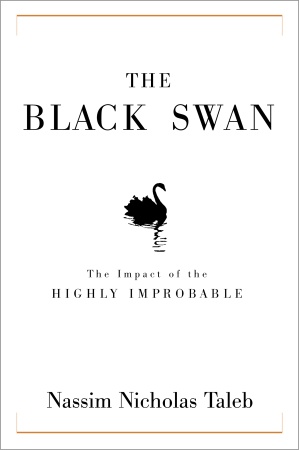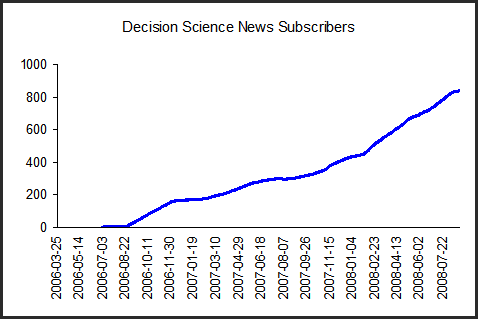TEST YOUR KNOWLEDGE OF THE INCOME DISTRIBUTION

Think you know it all? A good deal of decision-making research centers around people’s abilities to make accurate estimates and inferences.
Those who like to test their knowledge might be interested in this fun video game / Web experiment put together by Decision Science News and Lionel Page.
In it, you get to enter your beliefs about the inequality of income in the USA, and at the end, you can find out how accurate you were. Fun!
Give it your best shot at: http://www2.decisionresearchlab.com/db/hi/
Filed in
Jobs
 Subscribe
Subscribe to Decision Science News by Email (one email per week, easy unsubscribe)
OPT-IN TO OPIM

The OPIM Department at the Wharton School is home to faculty with a diverse set of interests in decision-making, information technology, information strategy, operations management, and operations research. We are seeking applications for tenure-track positions starting in the 2009-2010 academic year. Applicants must have the potential for excellence in research and teaching in the OPIM Department’s areas of concern. Rank is open. A Ph.D. is required.
Applications consisting of PDF files with (i) a one-page cover letter (ii) a resume or CV(iii) at least one research paper(iv) three contacts for letters of recommendation (v) a list of any upcoming conferences at which you plan to present your work should be entered at: http://opim.wharton.upenn.edu/home/recruiting.html.
The department will begin reviewing applications on November 17, 2008. To ensure full consideration, materials should be received by November 17th, but applications will continue to be reviewed until appointments are made.
The University of Pennsylvania is an Equal Opportunity Employer. Minorities, females, individuals with disabilities, and veterans are encouraged to apply.
INCREASE VOTER TURNOUT AMONG STUDENTS

Columbia University’s Eric Johnson and Elke Weber have created Teachers4Turnout, a Web site / classroom activity to encourage voting among students. Check it out at http://www.teachers4turnout.org. Here’s how they describe it:
The upcoming election is important to us, but even more important to our students. Decisions made by those officials who will be elected November 4th will affect the future of the country that our students will inherit. Our goal is to increase student participation in the electoral process. Studies show that we can increase voting substantially with a simple question: Merely asking students if they will be voting increases turnout, by getting their commitment to vote.
After you sign up, you will find a suggested script that is designed to encourage voting. This should take less than 5 minutes of class time. We will also send you no more than two reminder emails and ask you, after election day, how things went. That’s all.
Please help spread the word by forwarding this message to colleagues who also teach voter-age populations. With your help, we can make Teachers4Turnout a national success, and help our students vote.
Those interested in the latest behavioral research on increasing voter turnout might wish to read Nudging turnout: Mere measurement and implementation planning of intentions to vote by the international team of Dan Goldstein (London), Kosuke Imai (Princeton), Anja Göritz (Würzburg), and the Peter Gollwitzer (NYU).
Filed in
Books
 Subscribe
Subscribe to Decision Science News by Email (one email per week, easy unsubscribe)
BANK FAILURE AND BLACK SWANS

Fully aware of the Nostradamus effect and every “cognitive fallacy” under the sun, Decision Science News does have to hand it to Nassim Taleb for warning about the domino effect we’re now seeing in banking.
Globalization creates interlocking fragility, while reducing volatility and giving the appearance of stability. In other words it creates devastating Black Swans. We have never lived before under the threat of a global collapse. Financial Institutions have been merging into a smaller number of very large banks. Almost all banks are interrelated. So the financial ecology is swelling into gigantic, incestuous, bureaucratic banks – when one fails, they all fall. The increased concentration among banks seems to have the effect of making financial crisis less likely, but when they happen they are more global in scale and hit us very hard. We have moved from a diversified ecology of small banks, with varied lending policies, to a more homogeneous framework of firms that all resemble one another. True, we now have fewer failures, but when they occur … I shiver at the thought.” From Taleb, N. N. (2006). The Black Swan.
Filed in
Gossip ,
SJDM
 Subscribe
Subscribe to Decision Science News by Email (one email per week, easy unsubscribe)
DECISION SCIENCE NEWS HEADING TOWARD 1000 SUBSCRIBERS

This 100 day moving average of RSS subscriptions to Decision Science News seems to suggest that readership is up, though one cannot know for sure without conducting elaborate significance tests. The site currently gets 3000 hits per day.
Decision Science News was created in 2004 as a kind of external memory of conference dates for its editor and a handful of professors and graduate students in the once-obscure field of judgment and decision making, so this is rather unexpected.
“Hits” refers to people visiting the site directly through their browser. RSS subscribers, shown in the graph, refer to the number of people who get the sites’ content delivered by RSS feed reader or by email. If you are not subscribed, you may do so in a couple easy ways.
The first is to copy the link under the big orange icon under the word “SUBSCRIBE” in the right margin and then paste it into an RSS feed reader, such as Google Reader, Bloglines (or Bloglines beta), or Netvibes.
The second is to subscribe by email. Just type your email in the box under the words “Get new posts by email”, also in the right hand margin. Once you fill out the verification form, you’ll receive an email that will allow you to confirm your subscription. (If you don’t get it, check your junk mail folder). As the box promises, you can easily unsubscribe yourself anytime.
Filed in
Books ,
Gossip
 Subscribe
Subscribe to Decision Science News by Email (one email per week, easy unsubscribe)
DE GUSTIBUS NON EST DISPUTANDUM?

This post got us thinking about chart critique. Charts are things we like to judge, as graph rating systems, and the name of the blog Junk Charts suggest.
What we wonder is will science ever be able to separate chart opinions from chart knowledge? Chart doxa from chart episteme? Consider that the Napolon’s March (above), so celebrated by chart guru Tufte , is detested by chart guru Kosslyn
, is detested by chart guru Kosslyn .
.
The Decision Science News editor cannot help but be reminded of teaching acting, which he did professionally for a dozen years. Actors make decisions while acting teachers take notes, and the notes usually take the form of “good move there”, “bad move there”, or “questionable move there”.
While acting is an art, one can learn to discriminate between good, bad, and questionable choices. This is because teachers make predictions and get feedback as to whether these predictions are correct.
A bad choice has been identified correctly if the scene falls flat two minutes later (as judged by everybody in the room, including the people acting in it). A questionable choice has been identified correctly if, two minutes later, some of the room liked it and the rest didn’t. A good choice has been identified correctly if, two minutes later, everybody says “excellent move there!”.
The reader might be thinking, yes, but isn’t good and bad acting just a matter of taste? Two responses. First, not as much as you might think when dealing with people learning to act. Mistakes just pop out, like a beginning clarinetist squeaking their reed. Second, there are questions of taste, and those are the ones that divide the audience reacation. The clearly good and bad moves are plain to see.
(By the way, actors who make bad choices almost never get work. They have trouble getting agents, and even if they do, with hundreds people trying for each paying job, they never get past the audition phase. A lot of prize-winning actors split the public opinion. A lot of actors who always make good choices never get a nod, though they do get steady work).
So, in acting, we can use the reaction of the room as a measurement. But in statistics, the science of measurement, there doesn’t seem to be as clear a criterion. Fields like Interaction Design may suggest good candidates, such as the number of milliseconds it takes to answer a question based on a chart, the correctness of answers based on people reading the chart, and so on. Can there ever be such a thing as expertise in judging what constitutes good, bad, and questionable choices in chart design?
ADDENDUM
David Weiss and Jim Shanteau have proposed a solution to the problem we pose above. See the comment below and this paper in Human Factors, and this one in the Journal of Behavioral Decision Making.
DOES EVIDENCE-BASED MEDICINE SUPPORT PARACHUTE USE?

In 2003, the characteristically less-than-hilarious BMJ published a satirical article entitled “Parachute use to prevent death and major trauma related to gravitational challenge: systematic review of randomised controlled trials.” It has its funny parts. The authors’ point is summarized in the abstract’s conclusion:
Conclusions: As with many interventions intended to prevent ill health, the effectiveness of parachutes has not been subjected to rigorous evaluation by using randomised controlled trials. Advocates of evidence based medicine have criticised the adoption of interventions evaluated by using only observational data. We think that everyone might benefit if the most radical protagonists of evidence based medicine organised and participated in a double blind, randomised, placebo controlled, crossover trial of the parachute.
Photo credit:www.flickr.com/photos/fongetz/1789740815/
Filed in
Jobs
 Subscribe
Subscribe to Decision Science News by Email (one email per week, easy unsubscribe)
JUNIOR PROFESSORSHIP AT CARNEGIE MELLON UNIVERSITY

The Decision Science News editor got his start at Carnegie Mellon University’s Children’s School and is happy to let readers know that the Department of Social and Decision Sciences at Carnegie Mellon University seeks candidates to fill a junior-level tenure track position in behavioral decision research.
Candidates must demonstrate a strong track record and have research interests related to the psychology of judgment and decision making (e.g., social psychology, cognitive psychology, social cognition, emotion, self-regulation, neuroscience, consumer behavior). We prefer candidates who can teach courses in the psychology of judgment and decision making, empirical research methods, or otherwise participate in the department’s undergraduate majors in Decision Science, Policy, and Management. Joint appointments are possible with other units on campus.
The department is interdisciplinary, including psychologists, economists, political scientists, and historians. It has particular research strengths in behavioral decision research, policy analysis, industrial organization, technological change, and computational social science. Current projects and faculty are described at the web site:
http://www.hss.cmu.edu/departments/sds/
Carnegie Mellon University is an Affirmative Action/ Equal Opportunity employer. We encourage minorities, women, and individuals with disabilities to apply.
Applicants should send a CV, reprints/preprints of peer-reviewed publications, 3 or 4 letters of recommendation, a statement of research interests, and a cover letter to:
Chair, Behavioral Decision Theory Search Committee (Psychology)
Carnegie Mellon University
Department of Social and Decision Sciences
208 Porter Hall
Pittsburgh, PA 15213-3890.
Review of applications will begin October 2nd. Applications received by October 1st are assured full consideration.
CMU-related posts on Decision Science News:
GERD GIGERENZER ON IGNORING INFORMATION FOR BETTER DECISIONS

Who: Gerd Gigerenzer, Director, Max Planck Institute, Berlin
What: The Rationality of Heuristics: Ignoring Information for Better Decisions
Where: Westminster Business School, Hogg Lecture Theatre
When: 17h15-19h
The academic year in London will get off to a stimulating start as one of Psychology’s leading intellectuals, Gerd Gigerenzer, will take the stage on Tuesday September 23rd, 2008 to kick off the Economics of Behavior and Decision Making seminar in London.
Gigerenzer is Director of the Center for Adaptive Behavior and Cognition at the Max Planck Institute for Human Development in Berlin and former Professor of Psychology at the University of Chicago. He won the AAAS Prize for the best article in the behavioral sciences. His book Gut Feelings: The Intelligence of the Unconscious was one of six nominees for the 2008 Royal Society Prizes for Science Books. He is the author of Calculated Risks: How to Know When Numbers Deceive You
was one of six nominees for the 2008 Royal Society Prizes for Science Books. He is the author of Calculated Risks: How to Know When Numbers Deceive You , the German translation of which won the Scientific Book of the Year Prize in 2002. He has published several other academic books on heuristics including, Simple Heuristics That Make Us Smart
, the German translation of which won the Scientific Book of the Year Prize in 2002. He has published several other academic books on heuristics including, Simple Heuristics That Make Us Smart (with Peter Todd & The ABC Research Group) and Bounded Rationality: The Adaptive Toolbox
(with Peter Todd & The ABC Research Group) and Bounded Rationality: The Adaptive Toolbox (with Reinhard Selten, a Nobel laureate in economics), Heuristics and the Law (Dahlem Workshop Reports)
(with Reinhard Selten, a Nobel laureate in economics), Heuristics and the Law (Dahlem Workshop Reports) (with Christoph Engel), Rationality for Mortals: How People Cope with Uncertainty (Evolution and Cognition)
(with Christoph Engel), Rationality for Mortals: How People Cope with Uncertainty (Evolution and Cognition) , and Adaptive Thinking: Rationality in the Real World (Evolution and Cognition Series)
, and Adaptive Thinking: Rationality in the Real World (Evolution and Cognition Series) .
.
ABOUT GIGERENZER:
Gerd Gigerenzer’s CV
Through Analysis, Gut Reaction Gains Credibility, The New York Times.
Smart Heuristics: Gerd Gigerenzer at Edge.org
Gigerenzer’s Books
NEW FACULTY OR GRAD STUDENT IN LONDON? JOIN THE EBDM SEMINAR EMAIL LIST:
To subscribe to the seminar series email list, please visit http://tinyurl.com/yvw2sr to opt in. You can easily unsubscribe anytime. Please pass this message on to those who may be interested in joining the email list.
The full schedule of talks at the Economics of Behaviour and Decision Making seminar series is maintained at http://www.decisionresearchlab.com/ebdm/
ASKING A LIBRARIAN

There is an interesting post and discussion at Statistical Modeling, Causal Inference, and Social Science about whether the Library of Congress stacks were ever open to the public. Andrew has detailed memories of roaming the stacks, including information on how they were configured (“like spokes on a wheel”), which if correct would suggest that he was in there. However, the commenters’ personal experience and Web research finds evidence of the stacks being closed. And when Decision Science News was a young Web log going to high school in Potomac, Maryland in the 1980s, it remembers being denied access to the stacks. Today, the grown-up blog has learned that questions about libraries are often best handled by librarians, and has made use of the “Ask a Librarian” features on the LOC web site. The response:
This is in response to your inquiry of August 14, 2008.
The book stacks of the Library of Congress General Collections are not open to the public. There are 75,000 titles of reference material in the Main Reading Room, some shelved on decks that are directly adjacent to this room, that self-serve for all researchers in the reading room.
Prior to 1989, temporary stack passes were granted to select researchers who provided information that such access was necessary to their research. The stacks were closed after this time due to the need to secure the stacks and protect the book collections. Additional information about the closed stack system is accessible at http://www.loc.gov/rr/security/stacks.html/
You and your friend are most welcome to come to the Library, register as researchers in LM140 (Madison Building), and use the reading rooms for research purposes. If you have any additional questions about the Library’s collections and services, please use the Ask-A-Librarian service again.
Thank you for using the Library’s Ask-A-Librarian service.
Sincerely,
Public Service & Collections Access Officer
Collections Access, Loan, & Management Division
Library of Congress
Washington, D.C. 20540-4630
202-707-7400
This blog hypothesizes that Andrew, probably a prodigious student, got a researchers’ pass. This hypothesis recently got some support as Andrew added, “They definitely let me in the stacks when I was in high school. But I don’t know the official policy. Maybe I had to fill out some sort of form to get into the stacks; I don’t remember.”
 Subscribe to Decision Science News by Email (one email per week, easy unsubscribe)
Subscribe to Decision Science News by Email (one email per week, easy unsubscribe)











